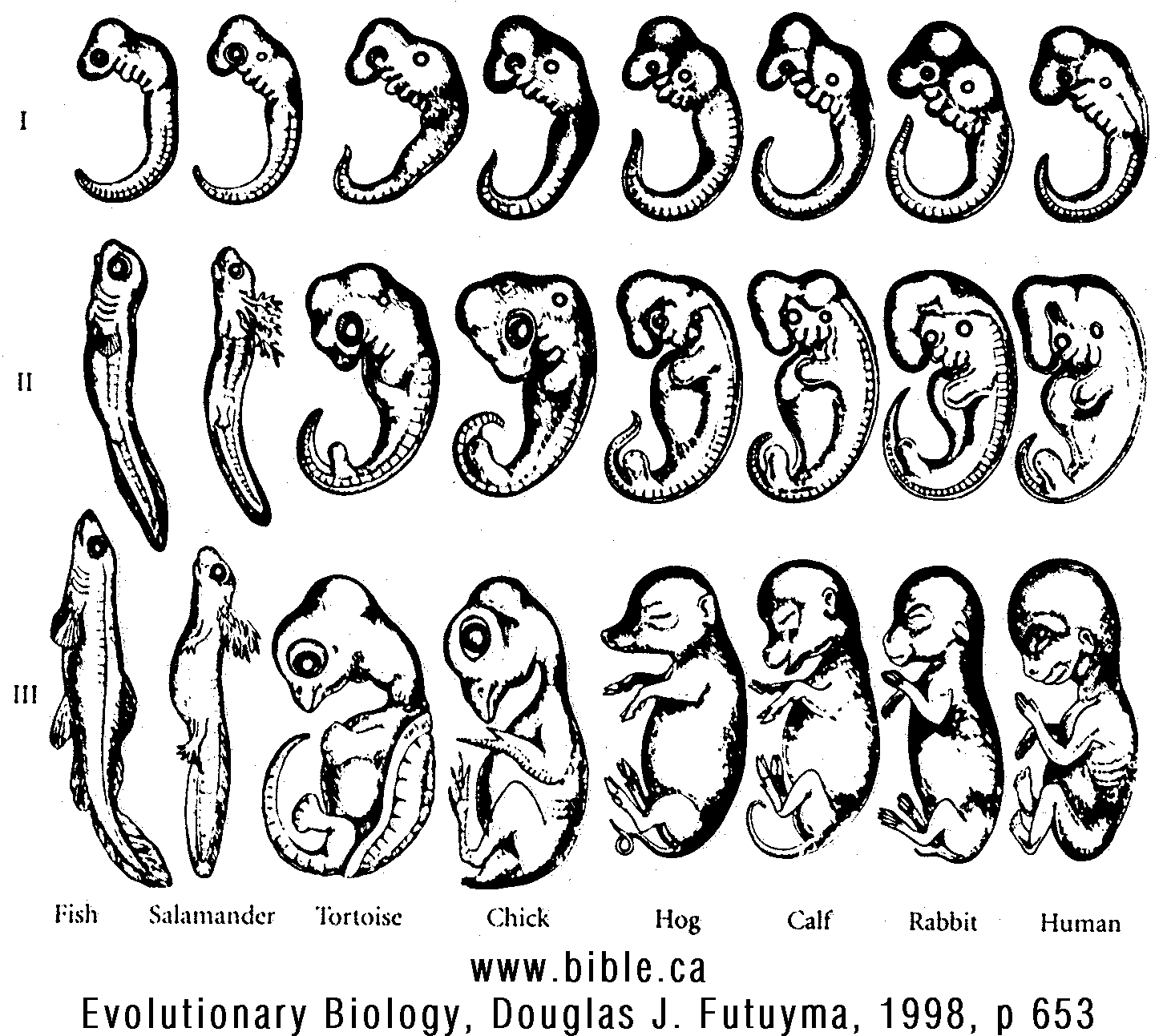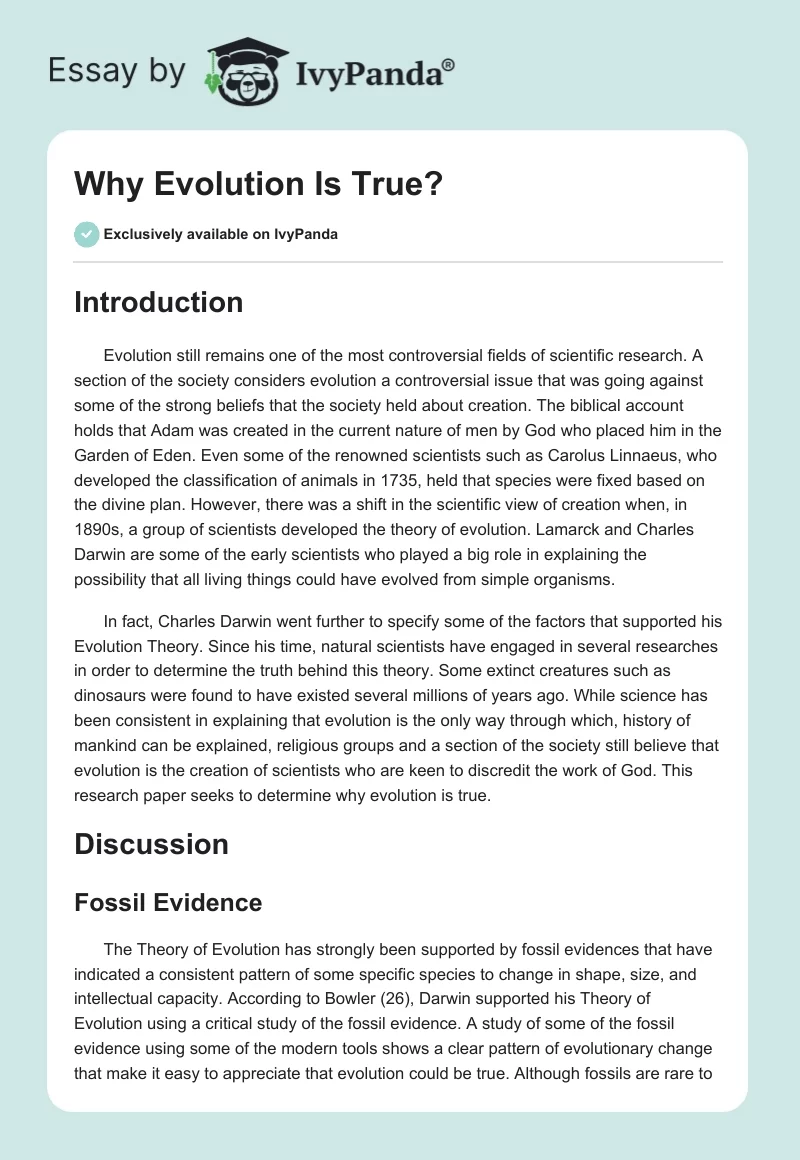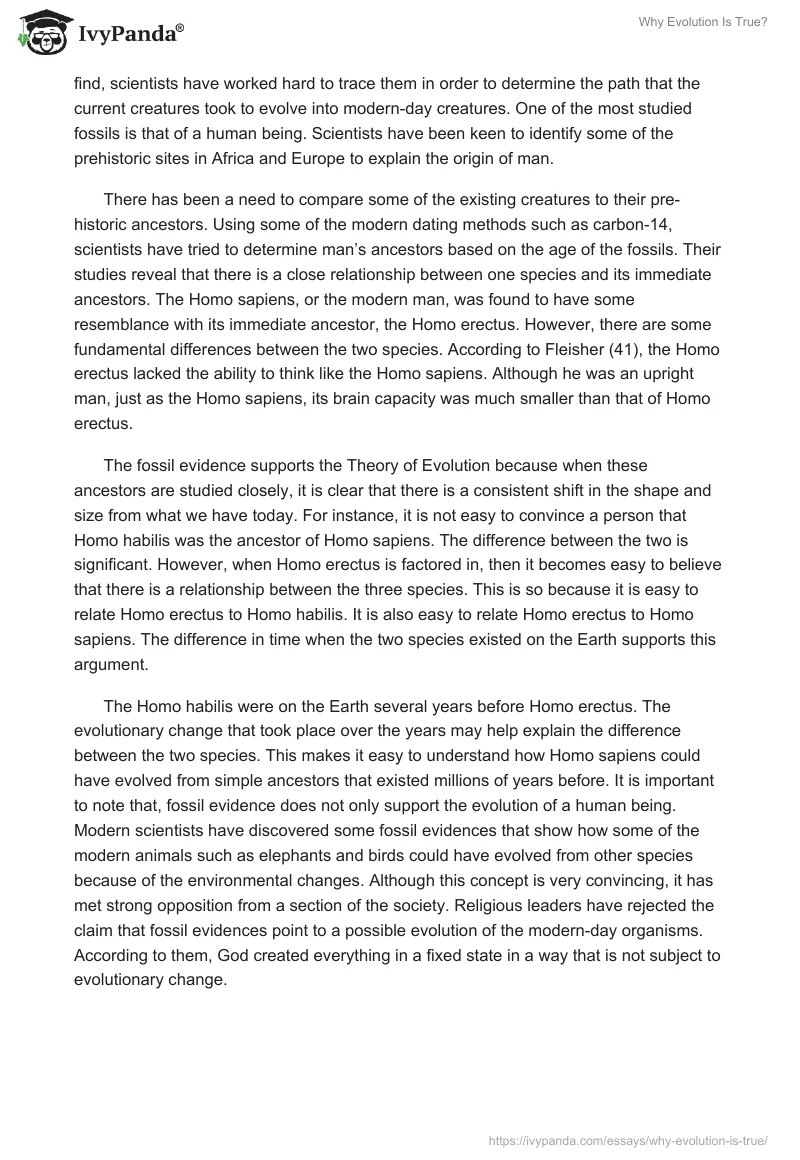Introduction
Evolution still remains one of the most controversial fields of scientific research. A section of the society considers evolution a controversial issue that was going against some of the strong beliefs that the society held about creation. The biblical account holds that Adam was created in the current nature of men by God who placed him in the Garden of Eden. Even some of the renowned scientists such as Carolus Linnaeus, who developed the classification of animals in 1735, held that species were fixed based on the divine plan. However, there was a shift in the scientific view of creation when, in 1890s, a group of scientists developed the theory of evolution. Lamarck and Charles Darwin are some of the early scientists who played a big role in explaining the possibility that all living things could have evolved from simple organisms.
In fact, Charles Darwin went further to specify some of the factors that supported his Evolution Theory. Since his time, natural scientists have engaged in several researches in order to determine the truth behind this theory. Some extinct creatures such as dinosaurs were found to have existed several millions of years ago. While science has been consistent in explaining that evolution is the only way through which, history of mankind can be explained, religious groups and a section of the society still believe that evolution is the creation of scientists who are keen to discredit the work of God. This research paper seeks to determine why evolution is true.
Discussion
Fossil Evidence
The Theory of Evolution has strongly been supported by fossil evidences that have indicated a consistent pattern of some specific species to change in shape, size, and intellectual capacity. According to Bowler (26), Darwin supported his Theory of Evolution using a critical study of the fossil evidence. A study of some of the fossil evidence using some of the modern tools shows a clear pattern of evolutionary change that make it easy to appreciate that evolution could be true. Although fossils are rare to find, scientists have worked hard to trace them in order to determine the path that the current creatures took to evolve into modern-day creatures. One of the most studied fossils is that of a human being. Scientists have been keen to identify some of the prehistoric sites in Africa and Europe to explain the origin of man.
There has been a need to compare some of the existing creatures to their pre-historic ancestors. Using some of the modern dating methods such as carbon-14, scientists have tried to determine man’s ancestors based on the age of the fossils. Their studies reveal that there is a close relationship between one species and its immediate ancestors. The Homo sapiens, or the modern man, was found to have some resemblance with its immediate ancestor, the Homo erectus. However, there are some fundamental differences between the two species. According to Fleisher (41), the Homo erectus lacked the ability to think like the Homo sapiens. Although he was an upright man, just as the Homo sapiens, its brain capacity was much smaller than that of Homo erectus.
The fossil evidence supports the Theory of Evolution because when these ancestors are studied closely, it is clear that there is a consistent shift in the shape and size from what we have today. For instance, it is not easy to convince a person that Homo habilis was the ancestor of Homo sapiens. The difference between the two is significant. However, when Homo erectus is factored in, then it becomes easy to believe that there is a relationship between the three species. This is so because it is easy to relate Homo erectus to Homo habilis. It is also easy to relate Homo erectus to Homo sapiens. The difference in time when the two species existed on the Earth supports this argument.
The Homo habilis were on the Earth several years before Homo erectus. The evolutionary change that took place over the years may help explain the difference between the two species. This makes it easy to understand how Homo sapiens could have evolved from simple ancestors that existed millions of years before. It is important to note that, fossil evidence does not only support the evolution of a human being. Modern scientists have discovered some fossil evidences that show how some of the modern animals such as elephants and birds could have evolved from other species because of the environmental changes. Although this concept is very convincing, it has met strong opposition from a section of the society. Religious leaders have rejected the claim that fossil evidences point to a possible evolution of the modern-day organisms. According to them, God created everything in a fixed state in a way that is not subject to evolutionary change.
Evo-devo and Deep Homology
Scientists have been looking for any evidence that can be used to support the idea that all living things have evolved from a common ancestor over duration of millions of years. Comparative embryology is one of the studies that has been conducted for some time now to help confirm the claim that all animals have the same ancestral origin, but evolved over the years into species with marked differences (Coyne 78). When embryos of different animals are studied at very early stages, it may not be easy to detect any difference among them. This can best be demonstrated using the diagram below.

As shown in the diagram, the study involved a close comparison of the embryos of fish, salamander, tortoise, chicken, hog, calf, rabbit, and human. These are animals that have distinct features in terms of physical structure, size, and the level of intelligence. Within the first week, all the embryos have very a close resemblance. In fact, the embryo of a human, rabbit, calf, hog, and chicken have close resembles that it may be difficult to tell one from the other. However, these embryos undergo consistent change in shape and size as time goes by, and in the second week, some major difference starts to appear. When the fetus is at advanced stages of development, then their physical appearance become distinct and the massive difference between the animals now become apparent.
This has been used as a scientific proof that at one time, these animals had one ancestor. However, due to fact that they were subjected to different environments and that there was a need to adapt to their environment, they evolved into the species we have today. As explained in the Theory of Survival for the Fittest, animals that were able to change with the changing environmental patterns were able to pass their desirable genes to the next generation. Those that were unable to change were swept away. This comparative embryology gives a clear indication of this same ancestry. This supports the claim that the theory of evolution is true.
Macroevolution: Speciation
The study of macroevolution has been one of the most interesting scientific researches in this field of evolution. In this study, scientists focused on determining the possibility that some animals could have had the same ancestor, but because of the difference in the environmental patterns, they were forced to evolve into unique species in the process many scientists have called speciation. The narrative about iguanas may help explain this process of speciation. At one time, they were of the same species and could easily mate and mingle as a large family. Then one day a group is separated from the larger family when the tree they were in falls in water and drifts to an island where there are no other iguanas.
This small group finds themselves in a new environment that has different requirements, and so they have to adopt. After some time, the iguanas that were swept to a new island will have marked physical differences from those that remained in the mainland. The difference may get more pronounced the more the two groups stay away from each other.
The environmental features will shape the nature of the two groups and they may develop into two different species. The African lion and American jaguar could have had the same ancestor. Similarly, snakes in various parts of the world have increasingly developed features that make the species distinct from one another. The speciation process takes place gradually, but when it does, the final species becomes so distinct that they cannot even mate. This may explain what could have happened for various species to become what they are today. It explains why humans closely resemble apes and not reptiles. This has been used to support the theory that at one time humans and apes had one ancestor.
However, the macroevolution took place over millions of years leading to different species such as human, gorillas, chimpanzees, baboons, and monkeys. These animals have a close resemblance, but the difference in their shape, physical structure, and the level of intelligence can only be explained through the Theory of evolution. The evolutionary changes that have occurred in these animals over the years gave rise to different species. This theory also helps in supporting the argument that evolution is true.
Rise of Homo Sapiens
Scientists have been trying to explain why Homo sapiens are the only human species that currently inhabits the world. To explain this, two theories have been suggested to help investigate the evolution of man. The first theory is known as Out of Africa. This theory holds that, after development of the genus Homo, some members of this genus moved away from Africa and spread to other parts of the world. Those that remained in Africa evolved into Homo sapiens. When they started moving to other parts of the world, they met other members of the genus Homo, but there were marked physical differences that made them believe that these were different organisms. For this reason, they displaced these relatives without mating with them. That is how humans developed to be unique animals on Earth.
Another approach that scientists have used to explain the evolutionary change of human from the simpler ancestors to the modern human beings is the Multiregional Theory. This theory holds that Homo sapiens must have evolved in various sites from the species of Homo erectus. This theory holds that there was a gene flow that helped maintain close similarities despite the fact that these species were developing in different parts of the world. Although some scientists have approved of this theory, I believe that it lacks scientific facts. Most of the evolutionary changes in individual species from a given genus have been associated with changes in the environment.
It would be difficult to convince one that when iguanas were separated and subjected to different environments, they evolved into different species, but the same is not true about Homo sapiens. That will appear to be a clear indication that science is contradicting itself. This theory should be considered inferior to the Out of Africa Theory because it lacks scientific explanations on how the Homo sapiens in different regions evolved into the same species. This is scientifically unconvincing, and a contradiction to the theory of evolution itself.
Irreducible Complexity
Scientists have tried to come up with many explanations to support the evolution theory and how it has helped bring diversity in the world today. Irreducible complexity involves study of complex biological structures within the body of different living things that make them survive in their environment. All living things, including unicellular organisms, have complex structures that make them be able to eat, excrete, and reproduce (Futuyma 78). These complex biochemical pathways show a similar pattern in the activities that take place within different living organisms. For instance, cells within living organisms need energy to perform different functions.
This energy must be generated through the respiratory process. The cellular respiratory process that takes place in plant cells has a close relation with the cellular respiratory process that takes place in animals. They both involve the breakdown of biochemical energy into adenosine tryphosphate that is needed to run various activities within the cells. They all involve the use of oxygen to breakdown food substances into energy. This similarity in pattern could be pointing to a similar ancestry between different living things. It supports the argument that although evolutionary change resulted into differences in the physical structure of different living things, the cellular structure-especially their functionality, never changed. It remained the same, but these physical features changed because of the changes in the environmental factors.
Theological Perspective
Theologians have come out strongly to oppose the evolution theory, holding that all living things were created the way they are today. According to Bowler (78), theologians have their evidence in the bible or other holy books which states that man was created in God’s likeness. If this is to be true, then it can only mean that man was created the way he is today. Other living things were also created the way they are today. The bible says that God created the forest, animals and other living things and placed them under the command of man. The bible does not support the possibility that humankind could have evolved into simpler organisms.
The main challenge of the theological perspective of argument is based on the premise of absolute belief. Unlike scientists who have worked tirelessly to develop hard facts to support their evolution theory, the biblical account of creation simply says that God created everything within six days, and on the seventh day, he rested. This will require a lot of belief and trust in what the bible says. Some scientists have claimed that the biblical account is close to some of the scientific explanations. For instance, scientists have confirmed that Homo sapiens are some of the newest species on Earth. It means that they came into the world when it was ready to support human life.
The bible records that God placed Adam in the Garden of Eden when all other creatures had been created. He was coming to take charge of these other creations. That is why he was given a superior capacity to reason and be able to control other creations. Theologians have always argued that there is a supernatural power that has been responsible for the control of all that is happening under the sun. Science has not been able to explain some of the forces such as witchcraft or the power to perform magic. Although some scientists have refuted the claim that witchcraft exists, the truth is that there are some destructive or constructive superpowers that always affect humans in one way of the other. This only confirms the theologians’ argument of the existence of supernatural force that was responsible for the creation of all living things, including the heaven and the Earth.
Philosophical and Social Perspective
The evolution theory has elicited strong philosophical debates about the truth that this theory could be holding against the life-long belief that we were all created the way we are today. The scientific theory of evolution seems to be convincing, but there are some philosophical misconceptions about it that has posed serious questions in the society. For instance, science argues that the world was forced out of four elements. However, there has been no clear scientific explanation of the source of the four elements that existed on Earth. What science explains are the circumstances under which these four elements met, and the resulting objects.
The inability to explain their sources could only point out to the possibility that all creations could have been the work of a supreme being. It is also intriguing that it is only human being that has evolved into an intelligent being that can control the world. Scientists have been unable to explain why evolution only favored man and not other animals. It does not explain how man has found himself to be the center of power. This is intriguing because man was not taken in a different planet to evolve into a superior being before being brought to planet Earth. This only means that the evolution theory could be having some lapses in explaining the origin of the Earth and all the living and nonliving things on it.
Conclusion
Evolution Theory has been used by scientist to explain the origin of all the living things. Science seems to point out that at one time, there was only one ancestor for all living things, and this ancestor was a cell. However, environmental factors led to the emergence of different species that are currently in existence today. It is important to note that this theory has been challenged by theologians and philosophers on various grounds. This only means that scientists still have more explanations to make in order to support the theory of evolution.
Works Cited
Bowler, Peter J. Evolution: The History of an Idea. Berkeley: University of California Press, 2003. Print.
Coyne, Jerry. Why Evolution Is True. Oxford: Oxford University Press, 2009. Print.
Fleisher, Paul. Evolution. Minneapolis: Lerner Publications Company, 2006. Print.
Futuyma, Douglas. Evolutionary Biology. Sunderland, Mass: Sinauer, 1998. Print.


